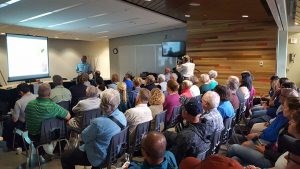
If you thought the number of trees affected by the mountain pine beetle was bad this year, you haven’t seen anything yet.
If experts are right the number of infected trees is expected to grow exponentially in the coming years, effectively turning Jasper National Park’s forest into a sea of red and dead pine trees.
From an ecological perspective this isn’t necessarily a bad thing, as mountain pine beetle are a naturally occurring species in Western Canada, however once the beetles move on they leave behind a forest of dry tinder that increases the wildfire risk to communities such as Jasper.
Earlier this week CAO Mark Fercho held a town meeting to discuss his experience dealing with the mountain pine beetle epidemic that swept through Prince George, B.C., when he worked for that city as the environmental services manager between 2002 and 2011.
“It’s the green trees that are full of beetles, not the red ones,” Fercho said, adding one infected tree can infect at least a dozen more if the conditions are right.
The latest numbers provided by Parks Canada estimate the pine beetle has already colonized 21,500 hectares of forest in Jasper National Park, more than three times the amount in 2014.
The mountain pine beetle kills pine trees by burrowing under the bark and mining the phloem, the layer between the bark and wood of the tree. The beetles then lay eggs under the bark. After the eggs hatch, the grub-like larvae spend the winter feeding under the bark. The larvae pupate in the spring and usually emerge as adults in the summer before flying onto the next mature pine tree.
In addition to the damage caused by the beetle, which has a one-year life cycle, the species transmits a blue stain fungus during colonization. The combination of beetle tunneling and blue stain fungi disrupts the movement of water within the tree, rapidly killing it and turning it red and dead.
The successful reproduction of the mountain pine beetle depends on several factors, including daily temperature fluctuations, under-bark temperatures and the ‘winter-readiness’ of beetle larvae.
According to the province, the temperature at which beetles start to die is not fixed, but varies given the larvae’s response to daily temperature fluctuations.
For example, an under-bark temperature of –37 C will kill 50 per cent of a mountain pine beetle population, however, a temperature of –20 C in the fall, before the beetles are prepared for winter, or in the spring, when beetles are starting to become more active, will also kill beetles if it is preceded by temperatures above 0 C.
When Fercho first started working for Prince George the mountain pine beetle was just starting to emerge in the central interior of British Columbia, however within a couple of years the city was inundated by the beetle, forcing it to cut down thousands of trees.
“When those big infestations were coming into Prince George you could actually catch them on weather radar,” said Fercho.
As trees began to turn red and dead he said the next concern was dealing with the increased fire risk posed by the trees.
To mitigate the risk the city cut down thousands of trees in public parks and along boulevards. At its peak the city cut down enough trees to fill 220 logging trucks.
Fercho admitted the changes were at first shocking for a lot of residents, but said it was necessary to protect the community.
“We did everything we could to advise people of the program, why we’re doing it and what it was about, but it still didn’t matter. When you show up with a feller buncher behind someone’s house or a logging truck people freak out,” said Fercho.
After thinning the city’s parks Prince George ran a community program replanting more than 6,000 trees.
“We actually ended up with more trees and more cash donations than we could plant or deal with,” said Fercho.
In July the municipality of Jasper began its annual tree program to identify and remove hazardous trees. Last year the town cut down approximately 300 trees.
During the meeting Fercho emphasized that while trees killed by the pine beetle increases the wildfire risk, it doesn’t change the overall threat wildfires pose to communities such as Jasper.
“Fire is fire, it doesn’t matter if it’s beetle infested or not,” said Fercho.
The main difference is a beetle-killed forest is much more volatile, sending embers soaring into the sky and starting spot fires ahead of the fire.
He said residents can mitigate the risk by fire smarting their homes by doing things like regularly cleaning their gutters and using fire-resistant materials when building their homes.
Last summer Parks Canada released its mountain pine beetle mitigation plan, which includes several strategies to slow the eastward spread of the beetle, including using prescribed burns, cutting down trees and using harvesting equipment to eliminate larger patches of infected forest.
According to the plan, Parks intends to carry out a series of prescribed fires immediately west of town on the bench. The prescribed fires (six in total) will eliminate dead trees located upwind from town, creating a buffer should a fire come from the west.
Some control line work has already been completed in preparation for the prescribed burns, which will only be held when conditions permit in late fall or early spring.
Once the prescribed fires are complete Parks estimates it will eliminate 420 hectares of mountain pine beetle habitat upwind from town.
Last year the Jasper Fire Department also received a $200,000 provincial grant to reduce the amount of fuel that has regrown in areas previously thinned by Parks Canada between 2003 and 2011, such as the fire road on Pyramid Bench.
“As far as other communities go, the work that Parks Canada has done in preparing Jasper for a wildfire is top-notch,” said Fercho.
Paul Clarke
[email protected]
